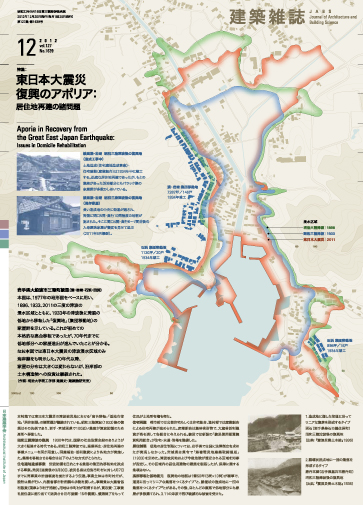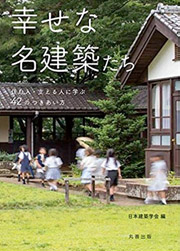本文PDFの閲覧につきましては、こちらでご確認ください。

2012-12月号 DECEMBER
特集= 東日本大震災 復興のアポリア
─居住地再建の諸問題
Aporia in Recovery from the Great East Japan Earthquake ─Issues in Domicile Rehabilitation
特集前言 復興事業化に向かう津波被災地― その枠組、力学、葛藤
東日本大震災の発災から1年半が過ぎた。津波被災地ではいよいよ復興計画の事業化に向けた動きが進みつつある。本誌としてはこの段階で噴出する諸課題をこそ的確にとらえておく必要があると判断し、本特集を企画した。現場を動かしている枠組と力学、関係者の苦闘、各所に顕在あるいは潜在する葛藤や摩擦を具体的にレポートし、解くべき難問(アポリア)がどこにあるのかを抽出して展望を模索したい。主として岩手県・宮城県の津波被災地の復興を主題とする本号は、福島原発被災地の諸問題を取り上げる次号(2013年1月号)とともに、被災地の現場に最も密着した特集号になるだろう。
本特集では、津波被災地の復興を特徴づける、互いに密接に関連し合う三つのトピック、①「集団移転」、②「低地市街地」、③「災害危険区域」を取り上げ、これらをめぐって被災地の地域社会、国・県と自治体、さまざまな立場の専門家が直面した諸課題にフォーカスを合わせることとした。
本号では外在的な批判は避け、事業化や制限指定の実際の局面を現実としてとらえ、具体的な報告を通じて課題を抽出することを編集方針としている(20世紀後半型災害復興のポリシーとスキームそのものを批判的に検証する特集は別に準備中である)。一方で、被災地の現実に通じていなければ具体的な矛盾を知りえず、しかもそうした立場の方々には現実の摩擦を赤裸裸に表に出すことは難しいという歯がゆいジレンマもある。執筆・座談会・インタビューのかたちでご協力くださった皆さんに感謝したい。
巻頭座談会は、国・県・市の復興ポリシーを描く仕事に責任ある立場で携わってこられた上田健、大西隆、岡田新一、佐藤隆雄の諸氏に、主に2011年度中に進められた復興計画策定を振り返り、課題を示していただいた。
つづいて第1 ~ 3部の各論に入るに先立ち、読者が特集を読むうえで前提となる、東日本大震災特有の復興関連事業・制限の枠組とその相互連関、主なキー・ターム等についての解説を会誌編集委員会にてまとめた。
第1部「集団移転―その決断、地縁と生活」では、大規模な津波災害に印象づけられた東日本大震災において発災直後から大きな話題となった高台への集団移転の諸問題を扱った。重村力、高鍋剛、服部卓也の三氏による包括的な座談会につづけて、勝田和一郎氏にはNPOの視点から住民の葛藤と可能性の萌芽を、また、宇野健一氏には気仙沼登米沢地区の計画支援を通じて主としてプランナーに求められる課題を書いていただいた。
第2部「低地市街地―その方法、備えとリスク」は、津波被害を受けた低地市街地をいかにとらえ、扱うかが主題である。大村虔一、佐々木一十郎両氏の対談では名取市閖上地区の現地再建、今西肇氏の寄稿では気仙沼市内湾地区の現地再建が取り上げられる。小川富由氏にはURによる自治体協力の取組みと復興住宅の役割、西尾久和氏には女川町における複数事業の適用によるまちの再編について論じていただいた。
第3部「災害危険区域―その必然、公益と権利」では、まず山田文雄氏に仙台市、佐藤清孝氏に気仙沼市の、それぞれにおける災害危険区域の指定とその根拠、関連する幅広い対応について語っていただいた。中村信義氏には、仙台市の荒浜地区について区域指定をめぐる被災者の葛藤・対立・不安の実相を綴っていただき、増田聡氏には区域指定が不動産に与える影響について論じていただいている。
特集全体を通じて、さまざまな立場の専門家が被災住民や被災地域と協働しながら手探りのなかで復興に取り組む努力とともに、多くの課題が浮き彫りになっている。事業メニュー先行型と地域の個別性との乖離、まちづくりの包括的な目標像の不在、国・県と自治体の役割、住民の意志、情報提供と合意形成のあり方、自治体行政の担い手不足と支援、事業による補助・融資等の格差、取り残される経済的弱者。今後も被災地の動向を注視していく必要がある。
会誌編集委員会
本号編集担当:森傑(北海道大学)、竹内泰(宮城大学)、大沼正寛(東北工業大学)、末廣宣子(NKSアーキテクツ)
[目次]
| 000 | 連載 再建への意志:図面のなかの都市復興 サンフランシスコの震災復興計画/阿部祐子 |
| 002 | 連載 東日本大震災|連続ルポ2|仮すまいの姿 民賃に分散居住する─仮住まいの新しいかたち/立木茂雄 |
特集 東日本大震災 復興のアポリア:居住地再建の諸問題
| 004 | 特集前言 復興事業化に向かう津波被災地─その枠組、力学、葛藤 |
| 006 | 巻頭座談会 復興計画策定のレビュー 上田健 × 大西隆 × 岡田新一 × 佐藤隆雄 |
| 012 | 特集を読むための基礎知識: 東日本大震災特有の復興計画・復興事業の構造と課題/会誌編集委員会 |
第1部 集団移転─その決断、地縁と生活
| 014 | 被災地域の多様性と計画手法 重村力 × 高鍋剛 × 服部卓也 |
| 018 | 被災地の葛藤と挑戦─NPOの視点から/勝田和一郎 |
| 020 | 見えてきた課題─気仙沼登米沢での計画支援を通じて/宇野健一 |
第2部 低地市街地─その方法、備えとリスク
| 022 | 対談 復興事業のプライオリティの定め方 大村虔一 × 佐々木一十郎 |
| 026 | 復旧から復興へまちづくりの挑戦─理想と現実の狭間で/今西肇 |
| 028 | 復興住宅の役割─ URによる自治体協力の取組みを通じて/小川富由 |
| 030 | インタビュー かつての町場を活かす─女川旧市街地の再生計画/西尾久和 |
第3部 災害危険区域─その必然、公益と権利
| 032 | インタビュー 災害危険区域の必要性と根拠/山田文雄 |
| 034 | インタビュー 区域指定と被災者支援のあり方、格差問題/佐藤清孝 |
| 036 | 行政「主導」で区域設定─翻弄される被災者/中村信義 |
| 038 | 住めなくなる土地の意味─不動産が受ける影響/増田聡 |
| 041 | 編集後記 森傑 |
| 041 | 次号予告 2013年01月号|特集:福島と建築学 |
| 042 | 特集を読んで 2012年10月号|特集:耐震の今:成熟から拡張へ それでも木造住宅の耐震化を一番に/川端寛文 阪神・淡路大震災と東日本大震災の教訓をどう活かすか/倉本洋 |
| 043 | 連載 建築の争点 幼保一体の環境ギャップ─大人と子どもが育ちあう保育建築を/佐藤将之 |
| 044 | 連載 なぜ私は建築を選んだか 興味のかけらをつないで/笠真希 |
| 045 | 連載 Architect Politician 石見利勝兵庫県姫路市長/石見利勝 |
| 046 | 連載 地域いろいろ・多様な日本 杉に恋して 秋田に出逢う─秋田杉恋プロジェクト/菅原香織 |
Preface to the Special Issue: Tsunami-Devastated Areas Moving toward Recovery Projects - The Frameworks, Dynamics, and Conflicts
A year and a half has passed since the Great East Japan Earthquake. At last the move to advance recovery plans into business projects is under way in tsunami-devastated areas, and our journal maintains that now is the time to accurately grasp each and every erupting problem. This is why we designed this feature. We would like to report on the frameworks and dynamics that move fields, the agony of the people involved, and the conflicts and frictions that exist clearly or latently everywhere, and, abstracting where the aporia is that needs solving, grope for an overview. This issue, whose theme is the recovery of tsunamidevastated areas in Iwate and Miyagi, together with the next issue (January 2013), which picks up all problems from Fukushima's nuclear-devastated areas, will be the feature issues that most adhere to the field of devastated areas.
In this feature, we pick up three topics that characterize recovery in tsunami-devastated areas and relate closely to one another - resettlement, tsunami hazard zone, and buffer zone - and within them focus on issues faced by devastated regional societies, the nation, prefectures, autonomies, and experts in various situations.
The editorial policy has been to avoid outside criticism, grasp the actual aspects of projects and restriction assignments as reality, and extract issues through concrete reports (separately we are preparing a feature of critical examinations into the policies and schemes behind disaster-recovery models in the second half of the 20th century). And yet, without being well-informed about the realities in devastated areas, no one can understand the concrete contradictions, and there is an irritating dilemma for people in such situations: it is difficult to reveal the naked truth of frictions. Thus, we appreciate people cooperating through writing, group discussion, and interviews.
In the opening conversation Takashi Onishi, Shinichi Okada, Takao Sato, and Ken Ueda, who have all worked in responsible positions drawing recovery policies for the nation, prefectures, and cities, review the creation of recovery plans, mainly promoted in 2011, and present some issues.
Next, before each of parts 1 to 3, the journal's editorial board organized explanations of recovery-related projects and restriction frameworks peculiar to the Great East Japan Earthquake, the chains of relations between them all, and the main key terms presumably needed for reading the feature articles.
Part 1, "Resettlement - The Decisions, Regional Bond, and Life," deals with issues of resettlement to higher ground, which became a big topic right after the Great East Japan Earthquake and its impression of enormous tsunami damage. Following a comprehensive conversation by Tsutomu Shigemura, Tsuyoshi Takanabe, and Takuya Hattori, Waichiro Katsuda writes from an NPO perspective about people's conflicts and the germ of possibilities, and Kenichi Uno by way of planning support at Toyomazawa district in Kesennuma writes about what tasks are required mainly of planners.
The theme of part 2, "Tsunami Hazard Zones - The Methods, Provisions, and Risks," is how to grasp and deal with lowland districts that suffered tsunami damage. Isoo Sasaki and Kenichi Ohmura talk about the reconstruction of the Yuriage district in Natori, and Hajime Imanishi's article picks up the reconstruction of the Naiwan district in Kesennuma. Tomiyoshi Ogawa discusses efforts at autonomous cooperation by Urban Renaissance Agency and the role of recovery housing. And Hisakazu Nishio discusses town reorganization through the application of plural projects in Onagawacho.
Part 3, "Buffer Zones - The Necessities, Public Welfare, and Rights," is related to impositions of buffer zones on originally inhabited areas. First, Fumio Yamada talks about Sendai, and Kiyotaka Sato about Kesennuma, each addressing the imposition of buffer zones, its basis, and related wide management. Nobuyoshi Nakamura writes about the actualities of victims' conflicts, oppositions, and anxieties over zoning in the Arahama district of Sendai, and Satoru Masuda discusses the influence of zoning on real estate.
Throughout the feature, as experts from various situations work with disaster victims and disaster areas, groping in their efforts at recovery, many issues have emerged: the separation between project-menu precedence and actual area individuality, the absence of any comprehensive image in town-planning goals, the roles of the nation and prefectures and autonomies, people's will, what offered information and agreement formation should be, the lack of workers in autonomy administration and support, inequalities of help and financing and so on by projects, and the economically weak being left behind. It is needed to watch for trends in devastated areas hereafter.
Editorial Board
This issue has been edited by Suguru Mori (Hokkaido University), Yasushi Takeuchi (Miyagi University), Masahiro Onuma (Tohoku Institute of Technology), and Noriko Suehiro (NKS architect).
[Contents]
| 000 | [Series] The Resolve to Rebuilding: City Reconstruction in Blueprint Recovery Plans from the San Francisco Earthquake / Yuko Abe |
| 002 | [Series] Great East Japan Earthquake Serial Report 2 Life in Temporary Housing Dispersed Living in Private Apartments ─A New Form of Temporary Living / Shigeo Tatsuki |
Special Feature
Aporia in Recovery from the Great East Japan Earthquake: Issues in Domicile Rehabilitation
| 004 | [Preface to the Special Issue] Tsunami-Devastated Areas Moving toward Recovery Projects─The Frameworks, Dynamics, and Conflicts |
| 006 | [Opening Discussion] Reviewing the Creation of Recovery Plans Ken Ueda × Takashi Onishi × Shinichi Okada × Takao Sato |
| 012 | Basic Knowledge for Reading the Feature Articles: Structures and Issues Peculiar to the Great East Japan Earthquake's Recovery Plans and Recovery Projects / Editorial Board |
Part1 Mass Moving ─The Decisions, Regional Relationships, and Life
| 014 | Diversity and Plan Techniques in Devastated Areas Tsutomu Shigemura × Tsuyoshi Takanabe × Takuya Hattori |
| 018 | The Struggle and Challenge of People in Disaster-Affected Areas ─From the Perspective of a Nonprofit Organization / Waichiro Katsuda |
| 020 | The problems discovered through the restoration planning support at Toyomazawa district, Kesennuma City / Kenichi Uno |
Part2 Lowland Urban Districts ─The Methods, Preparations, and Risks
| 022 | [Dialogue] How to Set Priorities in Recovery Projects Kenichi Ohmura × Isoo Sasaki |
| 026 | Challenges for Town Recovery and Reconstruction ─Dilemma between Ideal and Reality / Hajime Imanishi |
| 028 | Housing reconstruction through the partnerships between the Urban Renaissance Agency and local municipalities / Tomiyoshi Ogawa |
| 030 | [Interview] Making Use of Former Urban Districts ─A Regenerative Plan for the Old Urban District in Onagawa / Hisakazu Nishio |
Part3 Disaster Danger Areas ─The Necessities, Common Good, and Rights
| 032 | [Interview] Necessities and Bases in Buffer Zones / Fumio Yamada |
| 034 | [Interview] What Zonings and Victim Support Should Be─ Issues of Inequalities / Kiyotaka Sato |
| 036 | Government-Initiated Zoning─ Victims at Its Mercy / Nobuyoshi Nakamura |
| 038 | The Meanings of the Uninhabitable Land / Satoru Masuda |
| 041 | [Editor's Postscripts] Suguru Mori |
| 041 | [Previews of Coming Issues] 2013, January|Fukushima and Architecture |
| 042 | [Reviews of Previous Issue] 2012, October|Earthquake Resistance Now: From Maturity to Expansion Still, Improvements to Seismic Safety in Wooden Houses Should Come First / Hirofumi Kawabata How to Best Use Lessons from the Hanshin-Awaji Earthquake and the Great East Japan Earthquake / Hiroshi Kuramoto |
| 043 | [Series] Issues in Architecture An Environmental Gap in Kindergarten-Nursery School Unification ─ Calling For Nursery Architecture Wherein Adults and Children Look After One Another / Masayuki Sato |
| 044 | [Series] Why and How I Chose Architecture Stringing Together Scraps of Interest / Maki Ryu |
| 047 | [Series] Architect Politician Toshikatsu Iwami, Mayor of Himeji City, Hyogo / Toshikatsu Iwami |
| 046 | [Series] Local Identities: Diverse Japan Loving Sugi and Meeting Akita─The AKITA SUGIKOI Project / Kaori Sugawara |




 『幸せな名建築たち 住む人・支える人に学ぶ42のつきあい方』
『幸せな名建築たち 住む人・支える人に学ぶ42のつきあい方』





